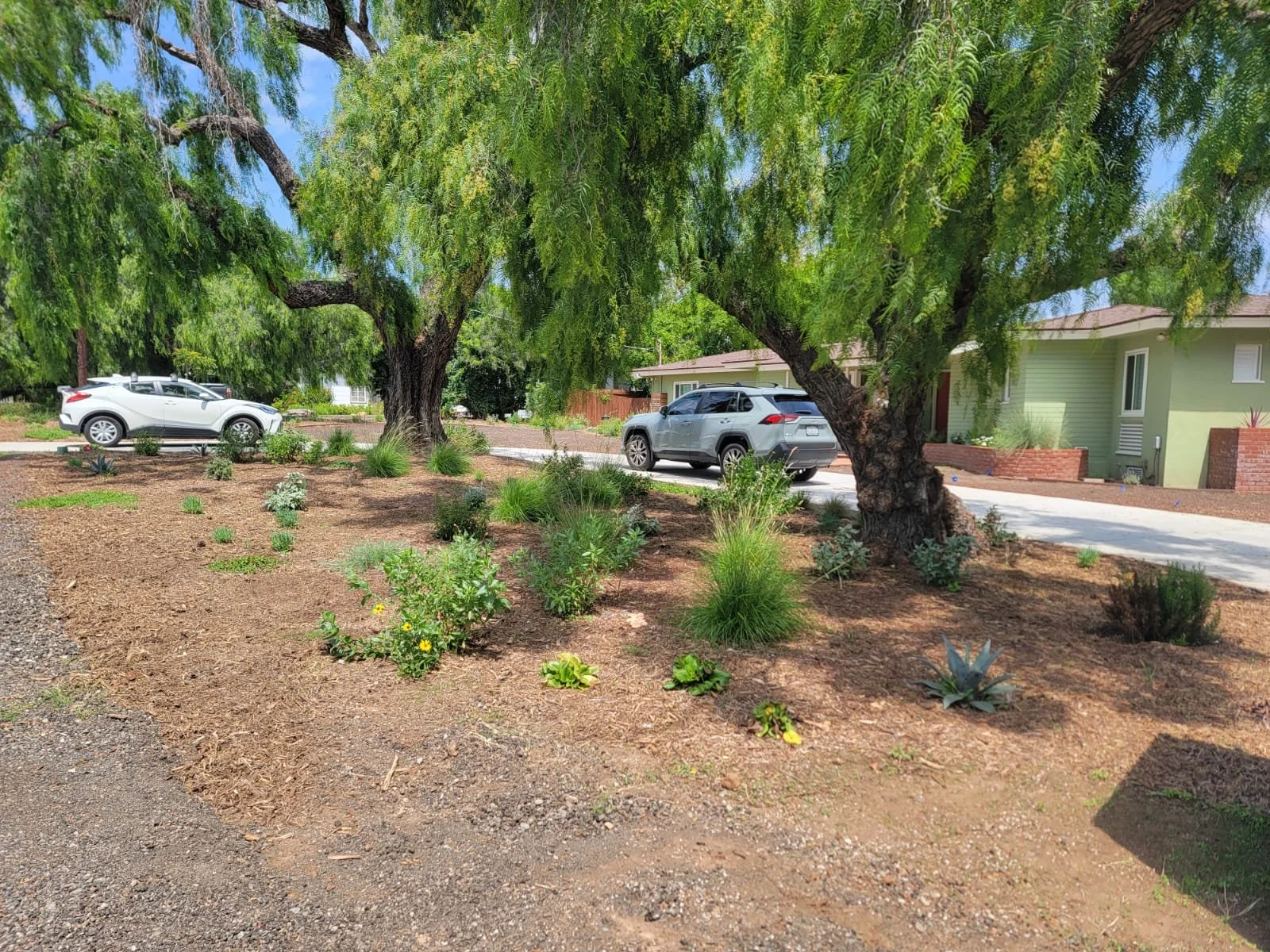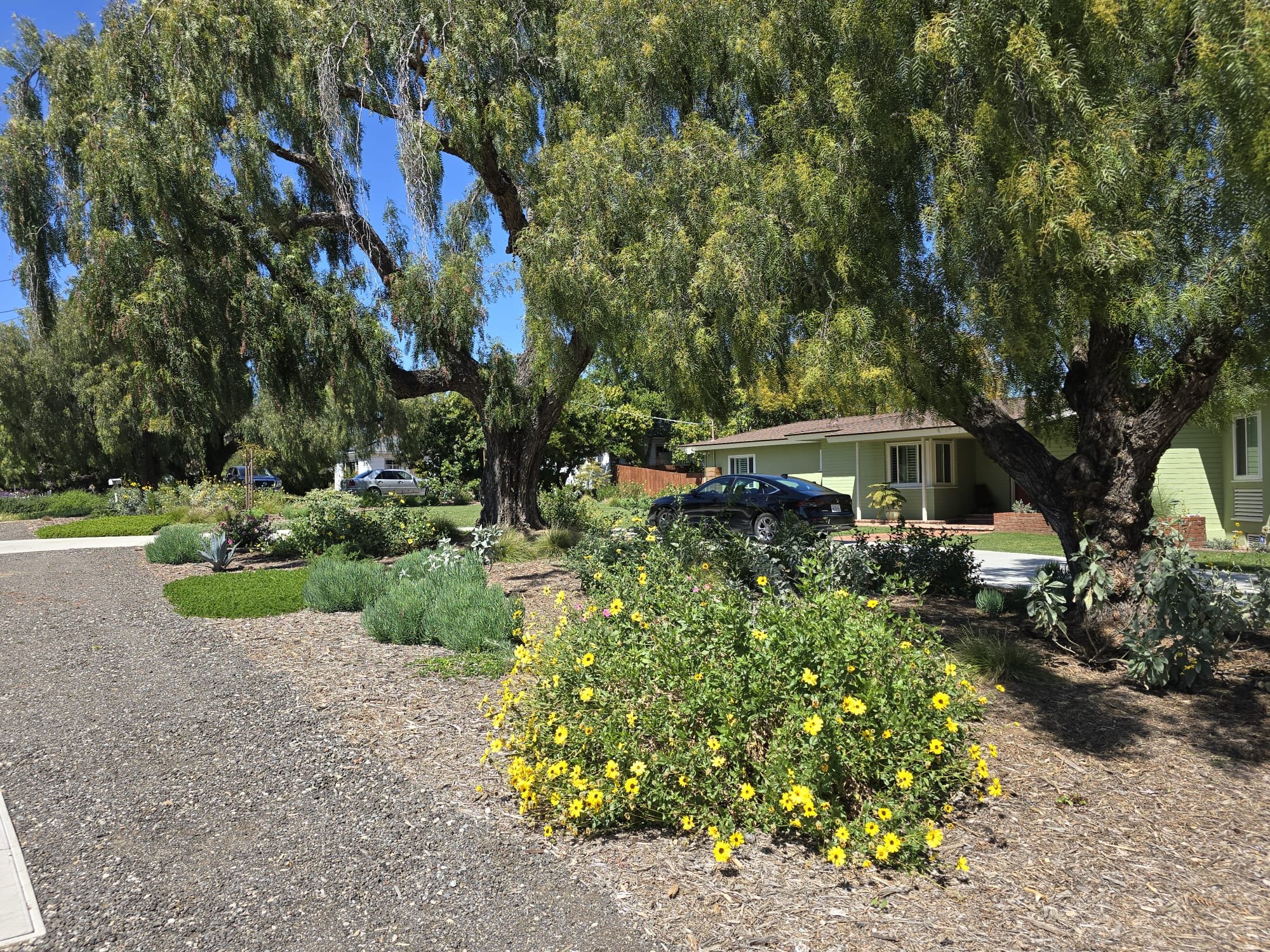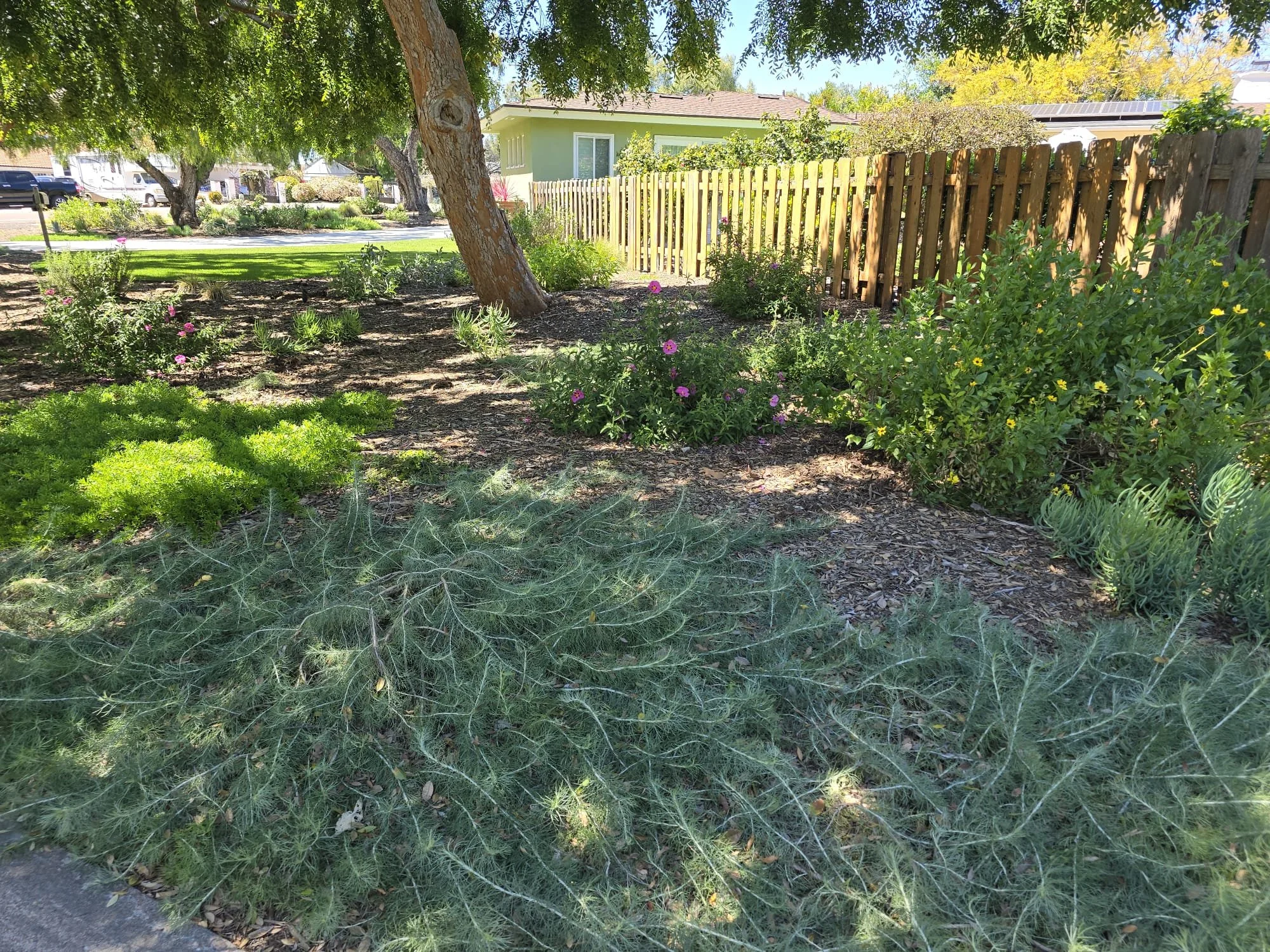Schinus molle, California Peppermint tree or Peruvian pepper tree
Beneath the graceful canopy of the California Peppermint Tree (Schinus molle), life continues in complex and fascinating ways. The micro-climate created by its aromatic leaves, shallow roots, and peppery resin influences everything that grows nearby. At LASD Studio, we approach such questions scientifically — analyzing soil chemistry, moisture balance, and ecological interactions to understand which species can truly thrive under this remarkable tree. This article explores the science behind Schinus molle and reveals groundcovers, ferns, perennials, and shrubs that not only coexist with it but also contribute to a balanced, living garden ecosystem.
Example of Newly planted vegetation under Schinus molle, by LASD Studio
California Peppermint Tree - Schinus molle
If you have a Peppermint tree on your property you might think - well, this is a mature beautiful tree, branches can be very sculpture like and beautiful. Also, many of us can wonder - What can grow under the California Peppermint tree?
Lets dive in and find out together.
Well, First of all at LASD studio we like scientific analysis and that is why we need to get some real data.
Schinus molle, commonly known as the Peruvian pepper tree or California pepper tree, is a species of flowering tree native to South America. It has adapted to various soil conditions and can tolerate a range of soil types. However, it generally prefers well-drained soils. Here are some soil conditions that are suitable for Schinus molle.
Well-drained soil: Schinus molle prefers soils that drain well and do not become waterlogged. Poorly drained or waterlogged soils can lead to root rot and other issues.
Neutral to slightly acidic pH: A pH range of 6.0 to 7.5 is generally suitable for Schinus molle. It can tolerate slightly acidic soils, but extremely acidic conditions may affect its growth.
Loamy or sandy soil texture: Schinus molle grows well in loamy or sandy soils that provide good drainage. These soil types allow water to pass through easily and promote healthy root development.
Moderate fertility: The tree can adapt to a wide range of soil fertility levels. However, it typically prefers moderately fertile soils. Adding organic matter, such as compost, to the soil can help improve its fertility and provide essential nutrients.
Tolerant of some salt: Schinus molle has moderate tolerance to salt, which makes it suitable for coastal areas where the soil may contain higher levels of salt. However, excessive salt content in the soil can still negatively impact its growth.
It's important to note that while Schinus molle is adaptable to various soil conditions, providing optimal growing conditions will help ensure its health and vigor. If you're planning to grow Schinus molle, it's always a good idea to observe the soil conditions in its natural habitat or consult with local gardening experts for specific recommendations based on your location.
After 1 year planting, under Schinus molle - design by LASD studio, ecological restoration
Ecological Design Perspective
Understanding what grows under Schinus molle is more than a gardening curiosity — it’s an ecological study in soil chemistry, allelopathic compounds, and adaptive symbiosis. At LASD Studio, every planting plan is rooted in this kind of data-driven exploration.
We integrate soil structure analysis, chemical composition mapping, and phytoremediation techniques to restore balance and biodiversity — whether under a single tree or across entire landscapes.
One of our ongoing projects demonstrates this approach in action — Mid-Century Modern design in Chula Vista — where degraded soil was regenerated through native understory planting, microbial activation, and precision irrigation modeling.
LASD Studio Mission video - Designing Landscapes that Heal, Endure and Evolve
But, wait! Why Schinus molle is toxic?
Schinus molle, also known as the Peruvian pepper tree or California pepper tree, contains certain compounds that can be toxic to humans and animals if ingested in large quantities. The tree's toxicity primarily stems from two main components:
Masticadienonic acid and related compounds: Schinus molle produces resinous compounds, including masticadienonic acid and related substances, which are found in various parts of the tree, including the leaves, bark, and fruit. These compounds can cause skin irritation and allergic reactions in some individuals. Direct contact with the sap or parts of the tree may lead to dermatitis or other skin-related issues.
Schinol and schinocarphol: The berries or fruits of Schinus molle contain a compound called schinol, also known as schinaceaeol. Schinol is a volatile oil that gives the tree its characteristic peppery scent. Ingesting large quantities of these berries, especially by children or pets, can cause gastrointestinal disturbances such as stomach pain, vomiting, and diarrhea. The seeds of the tree also contain schinocarphol, another toxic compound.
It's important to note that while Schinus molle is considered toxic, the severity of its effects may vary depending on the individual and the quantity ingested. Mild contact with the tree or incidental ingestion of a few berries is unlikely to cause significant harm, but caution should be exercised to prevent excessive exposure or consumption.
If you suspect ingestion or exposure to Schinus molle has occurred and symptoms are present, it is advisable to seek medical attention or consult a poison control center for proper guidance and assistance.
What Plants can grow under the California Peppermint tree and feel good? Can this really be true?
Well, Yes!
When selecting plants to grow under Schinus molle (Peruvian pepper tree), it's important to consider the tree's growth habits, shade tolerance, and the conditions it creates in the surrounding soil. Since Schinus molle can create a dense canopy and has shallow roots, it's often challenging for plants to thrive directly underneath it. However, there are some plant options that can tolerate the conditions provided by Schinus molle. Here you will find a few suggestions, that actually work!
10 groundcover plants that can potentially grow under Schinus molle (Peruvian pepper tree).
Here's a list of 10 groundcover plants that can potentially grow under Schinus molle (Peruvian pepper tree).
Shade-tolerant groundcovers: Opt for shade-tolerant groundcovers that can handle the reduced sunlight conditions under the tree. Some suitable options include Vinca minor (periwinkle), Pachysandra spp. (Japanese spurge), and Liriope spp. (lilyturf). These plants can form a low-growing carpet and help cover the soil.
Vinca minor (Periwinkle): This evergreen groundcover features attractive blue or purple flowers and glossy green leaves.
Pachysandra terminalis (Japanese Spurge): It forms a dense carpet of shiny, dark green leaves and produces small white flowers in spring.
Liriope spicata (Creeping Lilyturf): This grass-like groundcover has slender, arching leaves and produces spikes of lavender or white flowers.
Ajuga reptans (Carpet Bugleweed): It has low-growing foliage with vibrant purple, blue, or white flower spikes that add color to the ground.
Asarum europaeum (European Wild Ginger): This shade-loving groundcover has heart-shaped leaves and produces inconspicuous reddish-brown flowers.
Waldsteinia ternata (Barren Strawberry): It forms a dense mat of trifoliate leaves and produces bright yellow flowers in spring.
Herniaria glabra (Rupturewort): This low-growing, spreading plant has tiny, bright green leaves and is suitable for well-drained soils.
Lamium maculatum (Dead Nettle): It features variegated foliage and produces clusters of colorful flowers, usually pink, purple, or white.
Thymus serpyllum (Creeping Thyme): This fragrant groundcover forms a dense mat of small, aromatic leaves and produces tiny flowers in various colors.
Soleirolia soleirolii (Baby's Tears): It has tiny, round leaves that create a lush carpet-like effect and thrives in moist, shaded areas.
These groundcovers can provide coverage and interest under Schinus molle while tolerating shade and competition for resources. However, it's important to note that the success of these plants may still depend on the specific growing conditions of your location, so it's recommended to check their suitability for your region and consult with local gardening experts for personalized advice.
Another option to consider could be ferns!
Ferns are well-suited to the shade and can add a lush and tropical feel to the area under Schinus molle. Some fern species that tolerate shade include Boston fern (Nephrolepis exaltata), Maidenhair fern (Adiantum spp.), and Japanese painted fern (Athyrium niponicum).
One year after Planting, special ecological restoration by LASD Studio
10 fern species that can potentially grow under Schinus molle (Peruvian pepper tree)
Here's a list of 10 fern species that can potentially grow under Schinus molle (Peruvian pepper tree):
Nephrolepis exaltata (Boston Fern): This popular fern has arching fronds and thrives in shaded environments.
Adiantum spp. (Maidenhair Fern): Maidenhair ferns are known for their delicate, fan-shaped fronds and prefer moist, shady conditions.
Athyrium filix-femina (Lady Fern): It has graceful, feathery fronds and can tolerate shade and moist soil.
Dryopteris erythrosora (Autumn Fern): This fern features coppery-red fronds that mature to a glossy green and thrives in shade to partial shade.
Polystichum munitum (Western Sword Fern): It is a robust fern with dark green fronds and can tolerate both shade and sun.
Cyrtomium falcatum (Holly Fern): This evergreen fern has glossy, leathery fronds with distinctive holly-like leaflets and can handle shaded conditions.
Blechnum spicant (Deer Fern): It is a clumping fern with upright fronds and is well-suited for shaded areas.
Polypodium spp. (Polypody Fern): Polypody ferns are small, evergreen ferns that can tolerate shade and grow well in rock gardens or on walls.
Matteuccia struthiopteris (Ostrich Fern): This tall fern has large, arching fronds resembling ostrich feathers and prefers moist, shady conditions.
Polypodium vulgare (Common Polypody): It is a small fern with leathery, dark green fronds that can tolerate shade and dry soil.
These ferns can add a lush and tropical feel to the area under Schinus molle while thriving in shaded environments. However, it's important to consider the specific growing conditions of your location and the fern's hardiness zone to ensure their suitability. Consulting with local gardening experts or nurseries can provide you with more specific recommendations based on your region.
Ofcourse, we need our perrenials for the lush feeling of the garden.
Shade-tolerant perennials: Choose shade-tolerant perennial plants that can handle the competition for nutrients and moisture under the tree. Examples include hostas (Hosta spp.), coral bells (Heuchera spp.), and foamflowers (Tiarella spp.). These plants typically have attractive foliage and can add color and texture to the area.
20 perennial plants that can potentially grow under Schinus molle (Peruvian pepper tree)
Here's a list of 20 perennial plants that can potentially grow under Schinus molle (Peruvian pepper tree):
Hosta spp. (Hostas): These shade-loving plants come in a variety of leaf colors, shapes, and sizes, adding texture and interest to the area.
Heuchera spp. (Coral Bells): These perennials have attractive foliage in a range of colors and produce delicate flowers on tall stems.
Tiarella spp. (Foamflowers): Foamflowers feature mounds of foliage and delicate, spiky flowers in shades of white, pink, or purple.
Aquilegia spp. (Columbine): Columbines produce unique, spurred flowers in a variety of colors and are well-suited to partial shade.
Helleborus spp. (Hellebores): Hellebores are early-blooming perennials with elegant, nodding flowers in shades of white, pink, or purple.
Pulmonaria spp. (Lungwort): Lungwort plants offer attractive foliage patterns and produce clusters of flowers that change color from pink to blue.
Epimedium spp. (Barrenwort): These groundcover plants have delicate, heart-shaped leaves and produce dainty flowers in spring.
Geranium spp. (Hardy Geraniums): Hardy geraniums have attractive foliage and produce an abundance of flowers in various colors.
Digitalis spp. (Foxglove): Foxgloves add vertical interest with their tall flower spikes and come in various colors.
Astilbe spp. (Astilbes): These perennial plants have feathery, fern-like foliage and produce plume-like flowers in shades of pink, red, or white.
Brunnera macrophylla (Siberian Bugloss): It features heart-shaped leaves and produces clusters of small, forget-me-not-like flowers.
Euphorbia spp. (Spurge): Many species of Euphorbia are well-suited to shade and produce colorful bracts or flowers.
Dicentra spp. (Bleeding Hearts): Bleeding Hearts have unique, heart-shaped flowers that hang gracefully from arching stems.
Alchemilla mollis (Lady's Mantle): This perennial features soft, fuzzy foliage and produces chartreuse flowers in the spring.
Trollius spp. (Globeflowers): Globeflowers have bright, globular flowers on tall stems and prefer partial shade.
Lamium spp. (Dead Nettle): Dead Nettle plants offer variegated foliage and produce clusters of colorful flowers.
Persicaria spp. (Fleeceflower): Many Persicaria species thrive in shady areas and produce spiky flowers in shades of pink, red, or white.
Phlox stolonifera (Creeping Phlox): This low-growing phlox produces masses of flowers in various colors and spreads to form a carpet-like groundcover.
Polygonatum spp. (Solomon's Seal): Solomon's Seal plants have arching stems and produce delicate, bell-shaped flowers.
Tradescantia spp. (Spiderwort): Spiderwort plants have grass-like foliage and produce clusters of colorful flowers.
These perennials can add color, texture, and diversity to the area under Schinus molle. However, it's essential to consider the specific growing conditions of your location, such as soil type, moisture levels, and light availability, to ensure their success. Consulting with local gardening experts or nurseries can provide you with more specific recommendations based on your region.
Native woodland plants: Consider using native woodland plants that naturally thrive in shaded environments. Native plants are often well-adapted to the local climate and can establish themselves more easily. Some native options may include trilliums (Trillium spp.), wild ginger (Asarum canadense), or bleeding hearts (Dicentra spp.).
Also, Instead of planting directly under Schinus molle, another option is to use mulch to cover the ground. Mulching can help suppress weed growth, conserve moisture, and protect the soil. Wood chips, shredded bark, or leaf mulch can be suitable choices.
One year after landscape installation - landscape restoration
What are the best shrubs that potentially can grow under California Peppermin Tree?
When choosing shrubs to grow under Schinus molle (Peruvian pepper tree), it's important to consider their ability to tolerate shade, compete with the tree's roots, and thrive in the specific growing conditions provided by the tree. Here are 10 shrub options that can potentially grow under Schinus molle:
Fatsia japonica (Japanese Aralia): This evergreen shrub has large, glossy leaves and can tolerate shade and dry soil conditions.
Sarcococca spp. (Sweet Box): Sweet Box is a compact shrub that produces fragrant flowers in winter and early spring, and it thrives in shade.
Viburnum tinus (Laurustinus): This versatile shrub offers evergreen foliage and produces clusters of white or pink flowers in winter and early spring.
Mahonia aquifolium (Oregon Grape): Oregon Grape is an evergreen shrub with spiky foliage and yellow flowers in spring, followed by blue berries.
Daphne spp. (Daphne): Daphne shrubs produce beautifully scented flowers in various colors and are well-suited to partial shade.
Camellia japonica (Japanese Camellia): Camellias are prized for their showy flowers in winter and early spring and can handle partial shade.
Rhododendron spp. (Rhododendrons and Azaleas): These shrubs offer a wide range of flower colors and thrive in partial shade and acidic soil.
Hydrangea macrophylla (Bigleaf Hydrangea): Bigleaf Hydrangea produces large, round flower clusters and can tolerate partial shade.
Leucothoe spp. (Leucothoe): Leucothoe shrubs have attractive foliage and produce small, bell-shaped flowers. They prefer partial shade and moist soil.
Ilex vomitoria (Yaupon Holly): Yaupon Holly is a versatile evergreen shrub with small leaves and red berries, and it can tolerate shade and various soil conditions.
These shrubs can provide structure, color, and interest under Schinus molle while tolerating shade and competing with the tree's roots to some extent.
The plants that can tolerate shade and grow in pH 6.0-7.5 acid soil
Here's a list of 20 plants that are known to tolerate shade, thrive in the pH range of 6.0 to 7.5, and are generally suitable for growing in the San Diego area, this soil would be most likely under your California Peppermint Tree:
Aspidistra elatior (Cast Iron Plant)
Aucuba japonica (Japanese Aucuba)
Buxus sempervirens (Common Boxwood)
Caladium spp. (Caladium)
Clivia spp. (Clivia)
Dryopteris spp. (Wood Ferns)
Fatsia japonica (Japanese Aralia)
Hosta spp. (Hostas)
Hydrangea quercifolia (Oakleaf Hydrangea)
Mahonia spp. (Mahonia)
Nandina domestica (Heavenly Bamboo)
Pieris japonica (Japanese Andromeda)
Polystichum munitum (Western Sword Fern)
Rhododendron spp. (Rhododendrons and Azaleas)
Sarcococca spp. (Sweet Box)
Trachelospermum jasminoides (Star Jasmine)
Viburnum davidii (David Viburnum)
Vinca minor (Periwinkle)
Yucca filamentosa (Adam's Needle)
Zantedeschia spp. (Calla Lilies)
These plants are known for their shade tolerance, adaptability to the pH range of 6.0 to 7.5, and suitability for the San Diego area. However, it's essential to consider specific site conditions, microclimates, and individual plant requirements for optimal growth. Consulting with local nurseries or gardening experts in your area can provide further guidance and recommendations based on your specific location and preferences.
It's essential to consider the specific growing conditions, such as soil type, moisture levels, and light availability, when selecting plants. Additionally, regular monitoring and maintenance, including proper watering and occasional pruning, can help ensure the success of the plants under Schinus molle.
If you’re planning to redesign your garden or rewild an existing landscape, our team can help you understand the science beneath your soil and translate it into resilient, artful planting.
Contact LASD Studio to create a custom planting plan designed for your site’s micro-climate, soil chemistry, and ecological potential — where beauty and biodiversity grow together.





